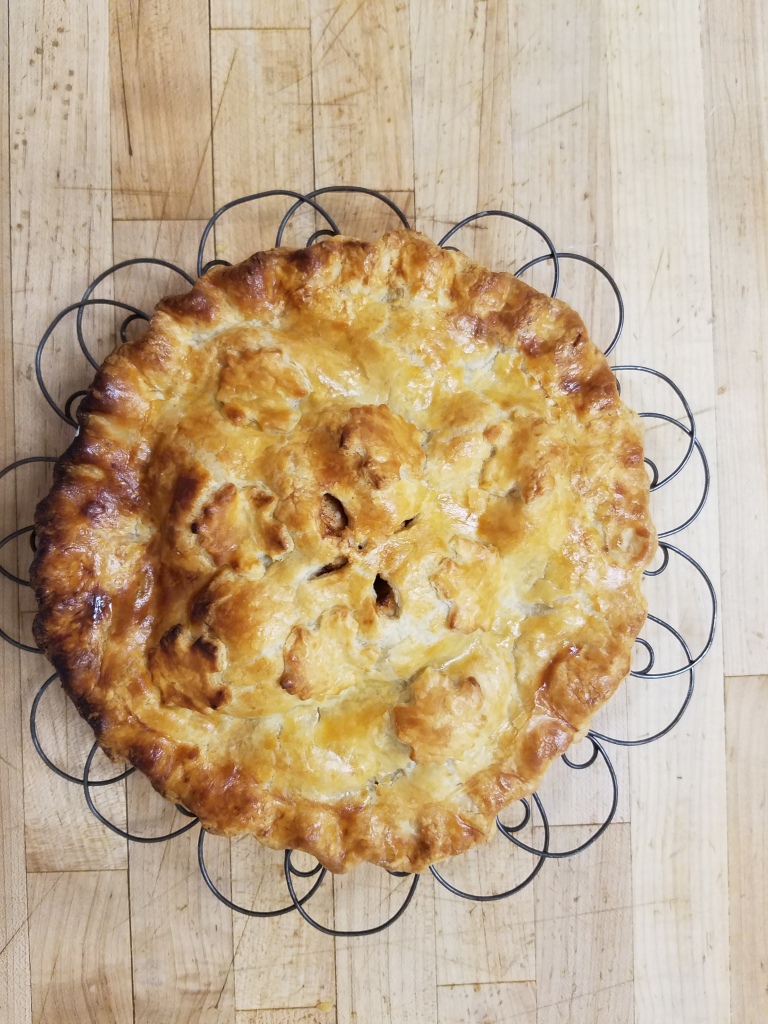 In class we made three different kinds of tarts. A lemon tart with meringue, a chocolate tart, and a fruit tart. Each tart had a brushing of chocolate at the bottom of it. For the lemon tart we made a lemon curd and filled the shell, then made a Swiss meringue to top it with, torching the meringue to finish the tart. For the chocolate tart we made a chocolate ganache and filled the shell, finishing off the tart with white chocolate designs. The fruit tart we filled with pastry cream then covered with sliced fruits, then brushed with a harmony glaze to give it a shine.
In class we made three different kinds of tarts. A lemon tart with meringue, a chocolate tart, and a fruit tart. Each tart had a brushing of chocolate at the bottom of it. For the lemon tart we made a lemon curd and filled the shell, then made a Swiss meringue to top it with, torching the meringue to finish the tart. For the chocolate tart we made a chocolate ganache and filled the shell, finishing off the tart with white chocolate designs. The fruit tart we filled with pastry cream then covered with sliced fruits, then brushed with a harmony glaze to give it a shine.
All my tarts turned out looking nice and I would probably make them the same way if I made them again. I especially like how the meringue turned out on my lemon meringue tarts, and I like the design on my chocolate tart.
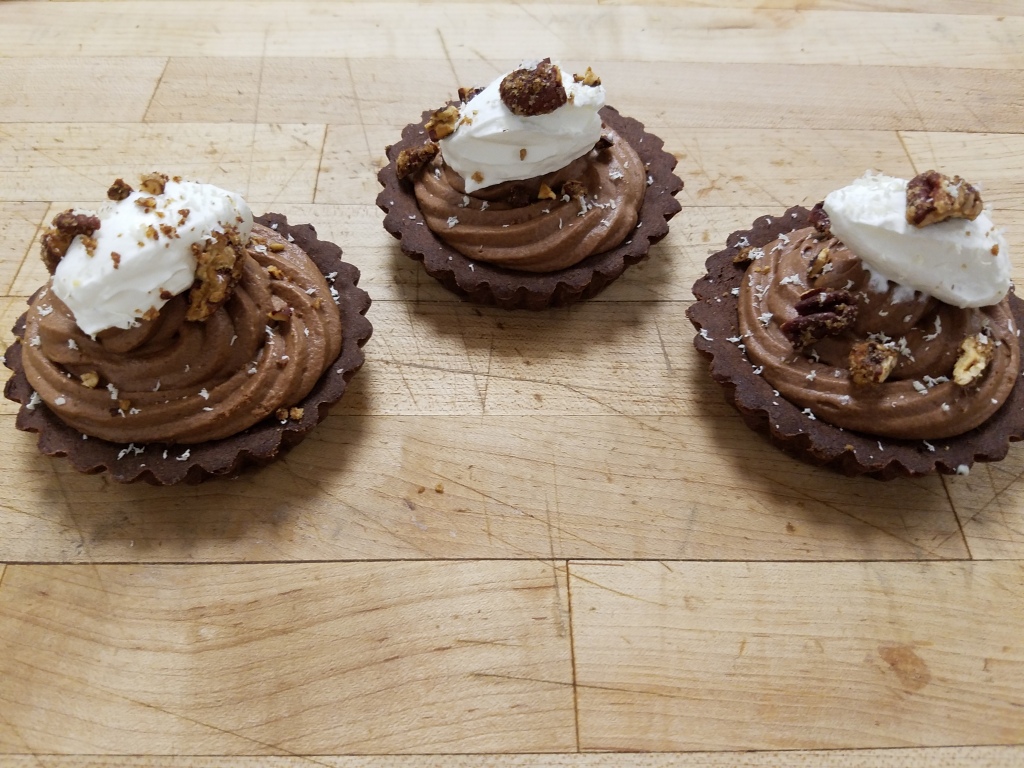 These mini pecan tarts were made with a short chocolate dough and a basic chocolate mousse. The chocolate dough was made with a mixture of pastry flour and cocoa powder so it still has a bit of structure, but it is still a softer dough since it is a short dough. The dough was rolled out and then blind baked before filling, and we brushed white chocolate on the bottom of the shell to create a barrier from the mousse. We made the mousse by whipping up some heavy cream and making a meringue, them folding them together with some melted chocolate. We piped this into the shell and then chilled it in the walk in fridge to allow it to set up. We whipped up some heavy cream and made some candied pecans that we chopped, then pulled the tarts out and garnished them with both the whipped cream and chopped nuts along with a little bit of shaved white chocolate.
These mini pecan tarts were made with a short chocolate dough and a basic chocolate mousse. The chocolate dough was made with a mixture of pastry flour and cocoa powder so it still has a bit of structure, but it is still a softer dough since it is a short dough. The dough was rolled out and then blind baked before filling, and we brushed white chocolate on the bottom of the shell to create a barrier from the mousse. We made the mousse by whipping up some heavy cream and making a meringue, them folding them together with some melted chocolate. We piped this into the shell and then chilled it in the walk in fridge to allow it to set up. We whipped up some heavy cream and made some candied pecans that we chopped, then pulled the tarts out and garnished them with both the whipped cream and chopped nuts along with a little bit of shaved white chocolate.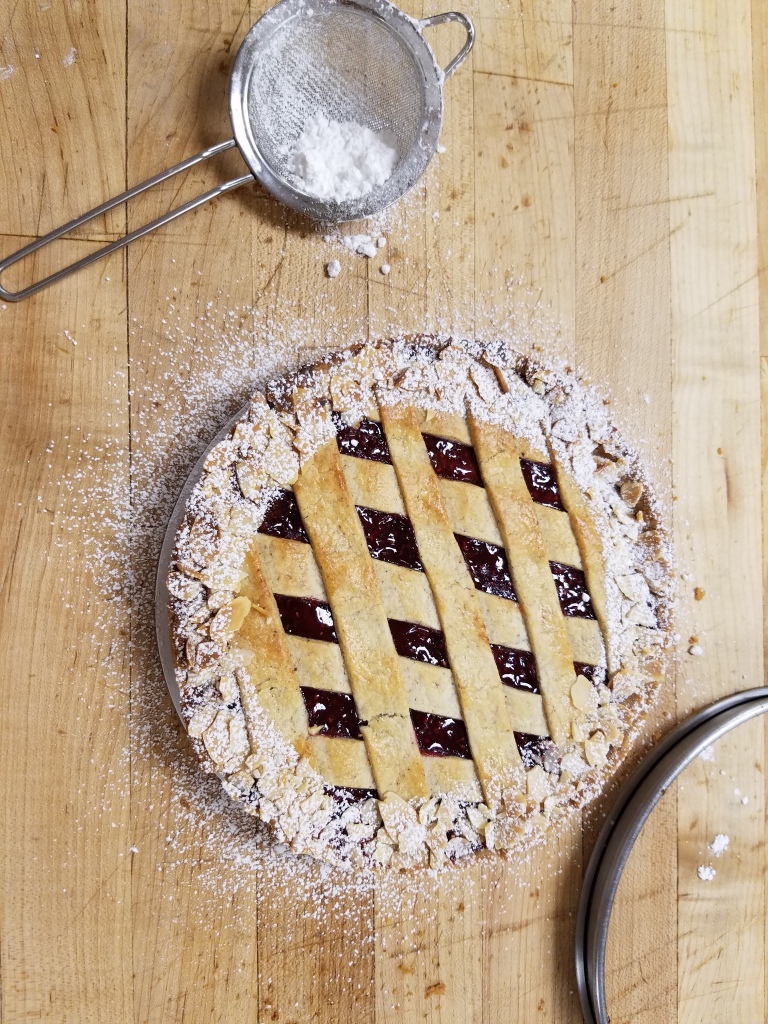 The Linzer Torte is made with linzer dough, which is a hazelnut short dough. It originated in Linz, Austria in the mid 17th century and is considered to be a lover’s torte, which makes it popular around valentines day. It is made a lot around holidays as well, including Christmas and new years but is not popular outside of the holidays. Traditionally it has an almond filling with a blackberry or red currant jam, but when the recipe was brought to America the traditional jams were replaced with raspberry jam. (Stradley)
The Linzer Torte is made with linzer dough, which is a hazelnut short dough. It originated in Linz, Austria in the mid 17th century and is considered to be a lover’s torte, which makes it popular around valentines day. It is made a lot around holidays as well, including Christmas and new years but is not popular outside of the holidays. Traditionally it has an almond filling with a blackberry or red currant jam, but when the recipe was brought to America the traditional jams were replaced with raspberry jam. (Stradley)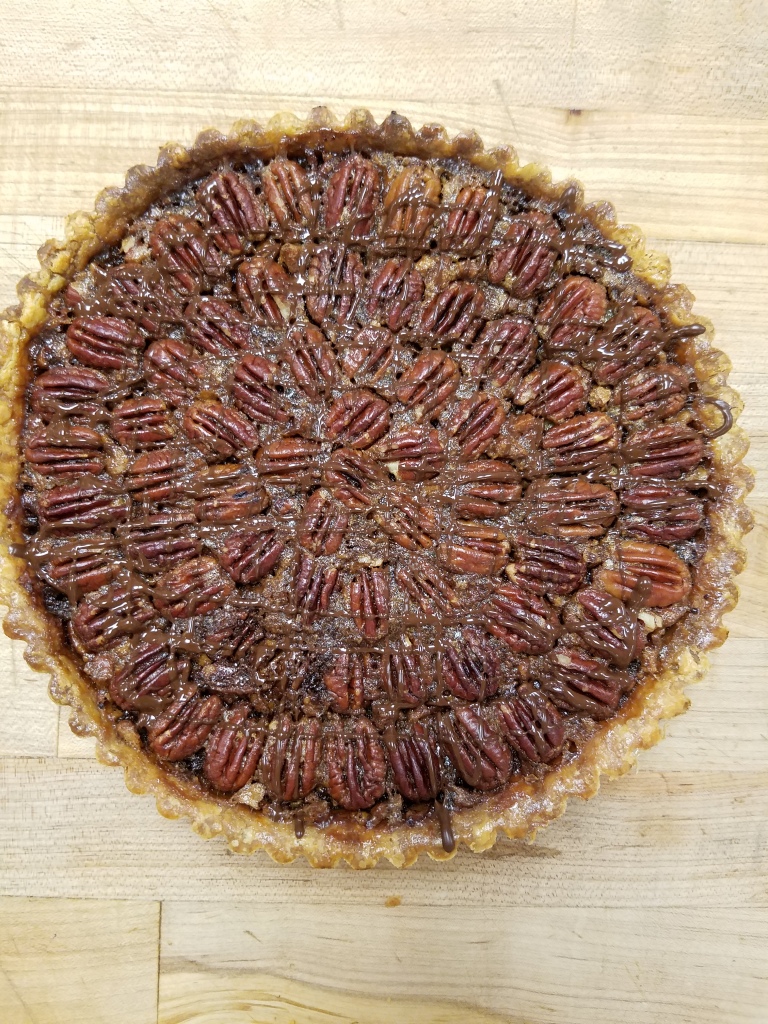 For the pecan tart we rolled out the dough and placed it in a fluted tin. We put chopped nuts and chocolate in the bottom of the tart and covered it with the sugar syrup. Then we placed pecans on the top of the syrup to ‘float’ and baked the pie until the middle set. After it was baked I drizzled chocolate over the top.
For the pecan tart we rolled out the dough and placed it in a fluted tin. We put chopped nuts and chocolate in the bottom of the tart and covered it with the sugar syrup. Then we placed pecans on the top of the syrup to ‘float’ and baked the pie until the middle set. After it was baked I drizzled chocolate over the top. This butternut squash pie is made the same way that you would make a pumpkin pie. We roasted the butternut squash in the oven, then put it through the food processor to make a puree. After that we added some liquids and spices to the puree to thin it out and flavor it, and then poured it into an unbaked bottom shell. Then we cut out some decorations for the top and put that on the outside of the pie. The pieces that were supposed to go in the middle we baked separately from the rest of the pie and put them on after everything was done baking.
This butternut squash pie is made the same way that you would make a pumpkin pie. We roasted the butternut squash in the oven, then put it through the food processor to make a puree. After that we added some liquids and spices to the puree to thin it out and flavor it, and then poured it into an unbaked bottom shell. Then we cut out some decorations for the top and put that on the outside of the pie. The pieces that were supposed to go in the middle we baked separately from the rest of the pie and put them on after everything was done baking.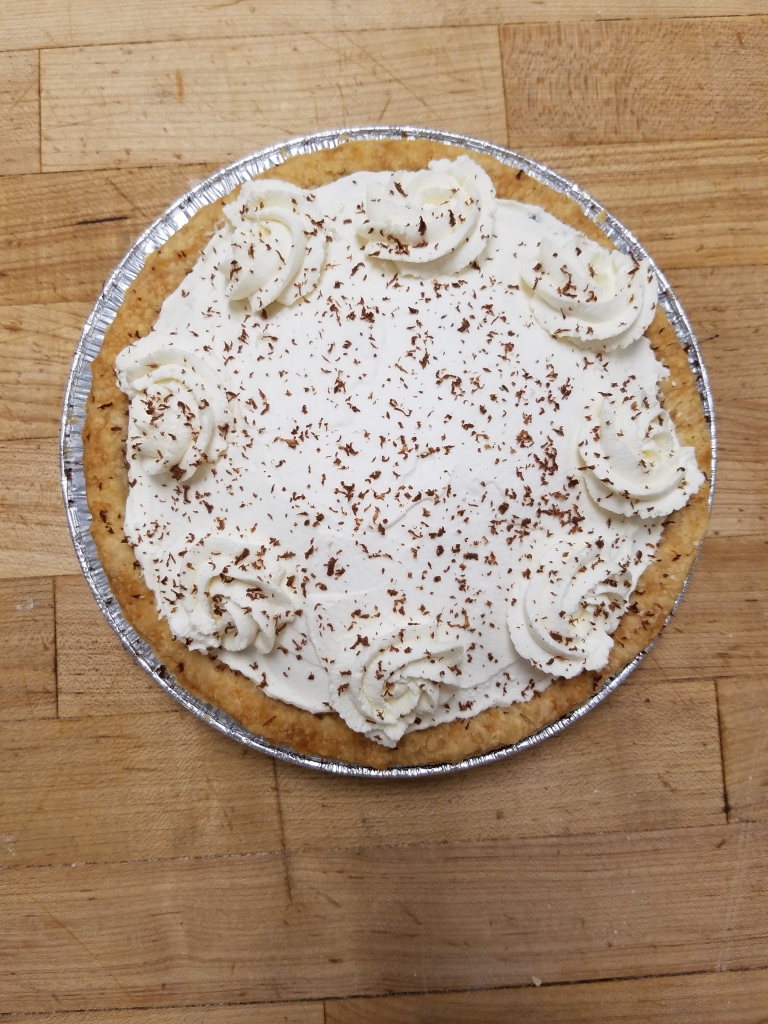 This chocolate cream pie is a very common pie. The filling is made the same way you would make pastry cream. After cooking the cream mixture and thickening it, I folded in some melted chocolate to flavor it. Then I poured it into a prebaked pie shell that was brushed with dark chocolate and chilled it to set. While it was chilling I made some chantilly to put on top, then mounded it up on top of the pie into a dome and piped rosettes around the edges. Then I shaved some chocolate to cover the top of the pie.
This chocolate cream pie is a very common pie. The filling is made the same way you would make pastry cream. After cooking the cream mixture and thickening it, I folded in some melted chocolate to flavor it. Then I poured it into a prebaked pie shell that was brushed with dark chocolate and chilled it to set. While it was chilling I made some chantilly to put on top, then mounded it up on top of the pie into a dome and piped rosettes around the edges. Then I shaved some chocolate to cover the top of the pie.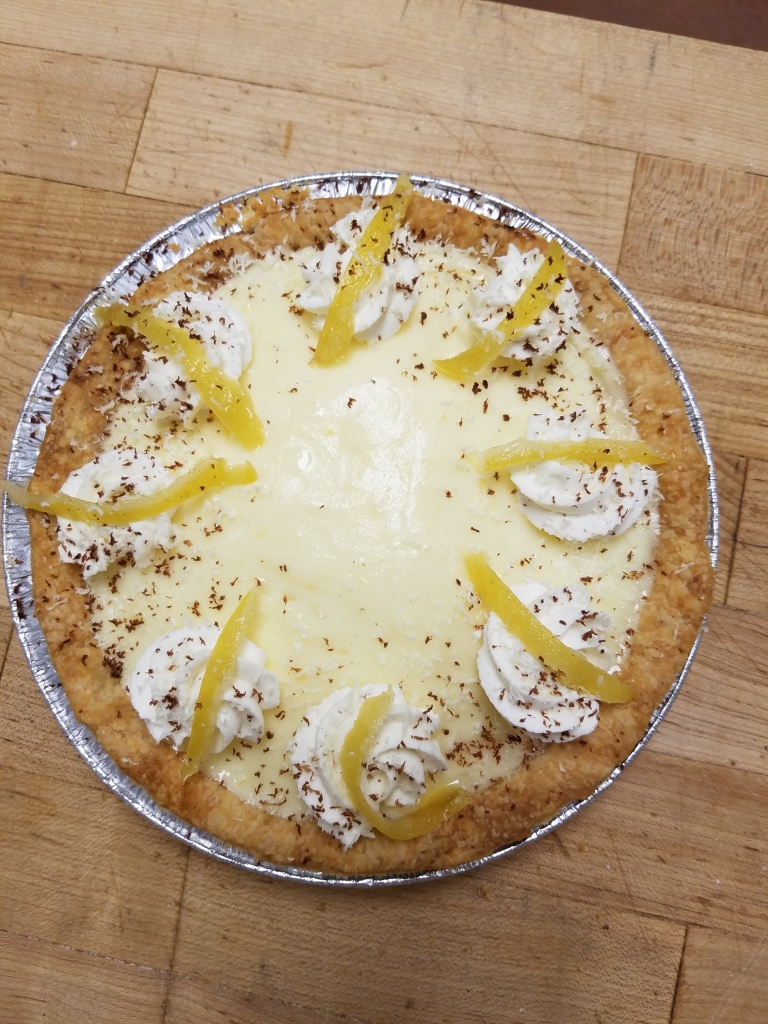 This lemon chiffon pie is made somewhat similarly to a cream pie. First we rolled out our dough and blind baked it with beans to hold it down. We made the filling by making a lemon-juice-egg mixture similar to how you would make a pastry cream. Then we folded in meringues to lighten the mixture up and poured it into the baked pie shells, which were brushed with chocolate on the inside, and put it in the fridge to set up. After that we made some chantilly and candied lemon and decorated the top with those and some shaved chocolate.
This lemon chiffon pie is made somewhat similarly to a cream pie. First we rolled out our dough and blind baked it with beans to hold it down. We made the filling by making a lemon-juice-egg mixture similar to how you would make a pastry cream. Then we folded in meringues to lighten the mixture up and poured it into the baked pie shells, which were brushed with chocolate on the inside, and put it in the fridge to set up. After that we made some chantilly and candied lemon and decorated the top with those and some shaved chocolate.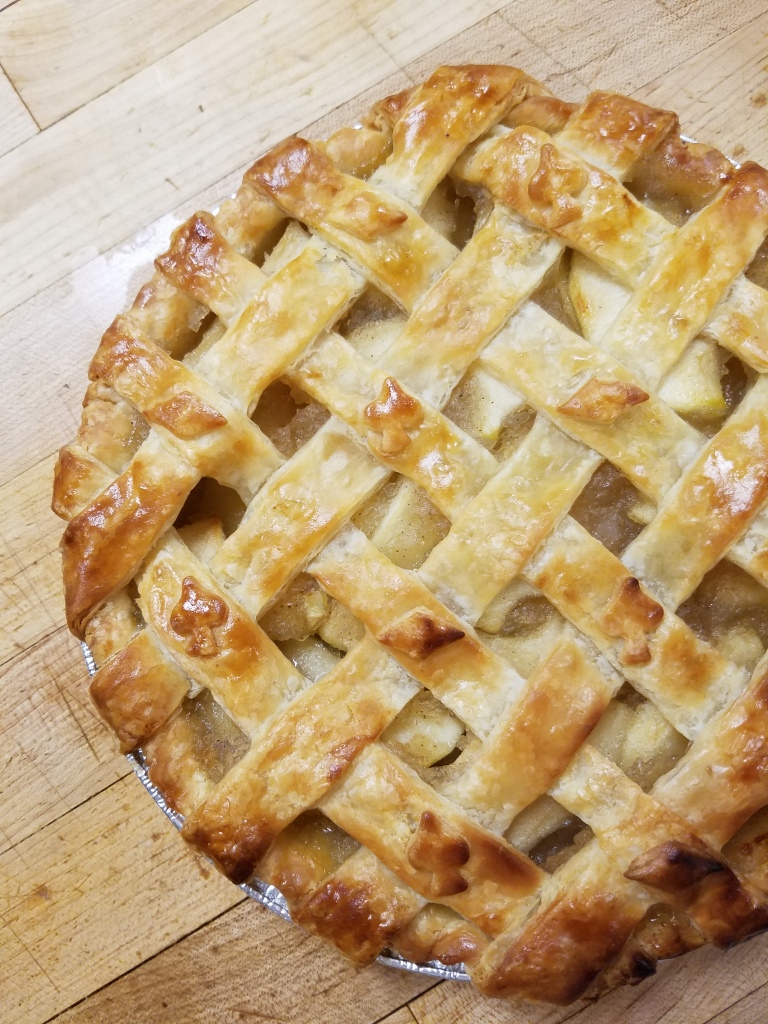 This apple pie we made second in class using a different technique than the homestyle pie from before. This time we used a cooked fruit and juice method, which is good to use on harder fruits that you want to be soft in the end product. We made the filling by cooking sliced apples in a pot with a bit of juice and bringing it to a boil. Once it boiled we made a slurry and put it into the pot with the apples and heated it until thickened. Then we rolled put the dough for the bottom of the pie and cut out strips for the top so we could made a lattice. We filled the pie then crossed the strips over the top to create the lattice and added small decorations. We egg washed them before baking, which helped to make the crust shiny when it is done.
This apple pie we made second in class using a different technique than the homestyle pie from before. This time we used a cooked fruit and juice method, which is good to use on harder fruits that you want to be soft in the end product. We made the filling by cooking sliced apples in a pot with a bit of juice and bringing it to a boil. Once it boiled we made a slurry and put it into the pot with the apples and heated it until thickened. Then we rolled put the dough for the bottom of the pie and cut out strips for the top so we could made a lattice. We filled the pie then crossed the strips over the top to create the lattice and added small decorations. We egg washed them before baking, which helped to make the crust shiny when it is done.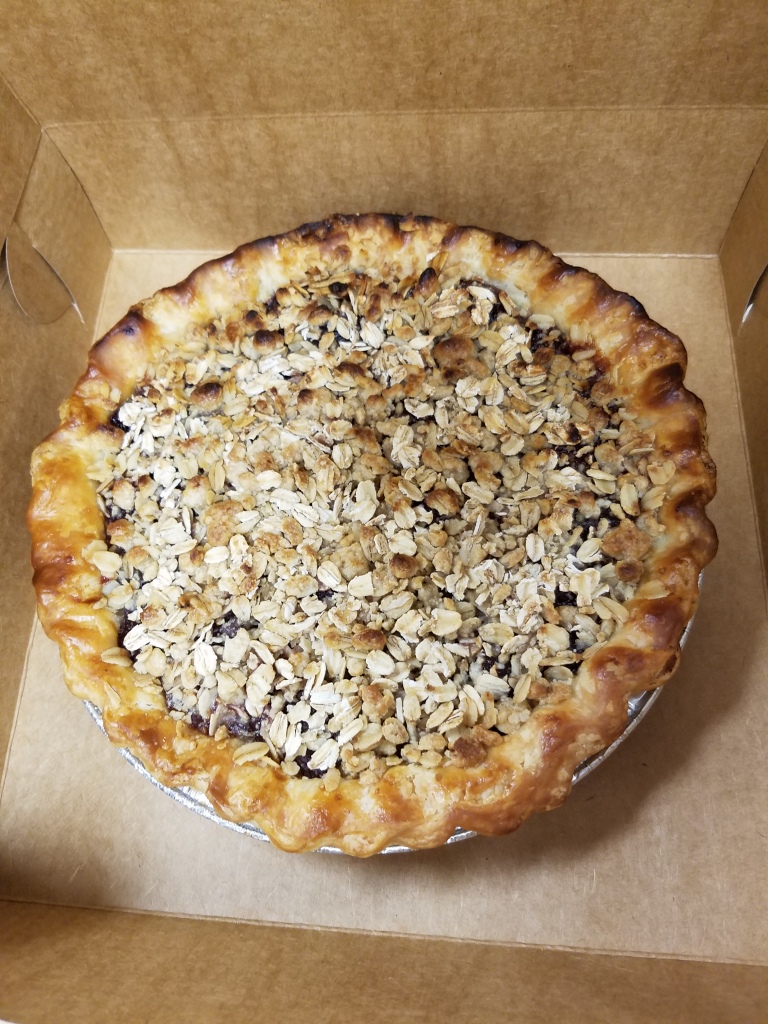 The cherry pie we made in class was made using a cooked juice method of making filling. We made it by first cooking the cherry juice with a bit of cornstarch and sugars and let it thicken until it was translucent, then we folded in the cherries. Making a filling this way is good when using a softer fruit because this keeps the fruit from breaking or popping so it is still whole for the most part in the end product. We rolled out our basic short flake pie dough and used it for the bottom crust, then we crimped it and added a streusel topping made with rolled oats.
The cherry pie we made in class was made using a cooked juice method of making filling. We made it by first cooking the cherry juice with a bit of cornstarch and sugars and let it thicken until it was translucent, then we folded in the cherries. Making a filling this way is good when using a softer fruit because this keeps the fruit from breaking or popping so it is still whole for the most part in the end product. We rolled out our basic short flake pie dough and used it for the bottom crust, then we crimped it and added a streusel topping made with rolled oats.